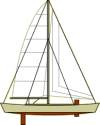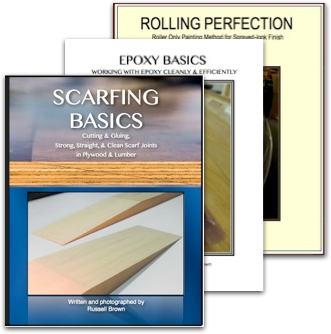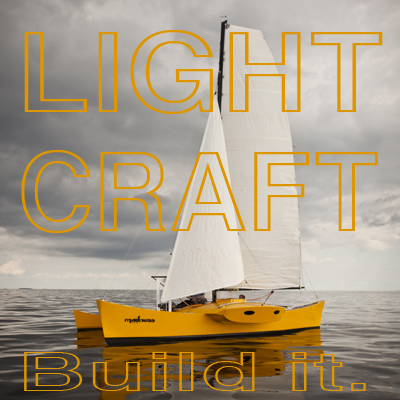Proa Rig Options: The Sloop
GALLERY | Click images to enlarge
The sloop is the rig of choice on 90% of all modern sailboats. Why not on proas as well? Here’s why.

Rigging a proa as a sloop is a true blending of East and West. The proa is considered the pinnacle of Pacific canoe design, and the sloop is often considered the finest invention of Western "yachting". Brilliant in their own context, what happens when we creatively recombine their DNA?
First consider the sloop. Beautiful, efficient, and handy, the sloop has been the darling of the yachting world for going on one hundred years. Refined over the years, and lavished with the latest hi-tech materials, the rig is versatile enough to please all-out racers and laid-back cruisers. When set up with a self-tending jib, the rig is simplicity itself to tack, needing only a gentle hand on the tiller to guide the boat through stays. When rigged as a racer, there are enough sails to change, winches to grind and strings to tweak to keep a large crew very busy. The rig works for small day sailors all the way up to 100’ mega-yachts.
Now consider the proa. The ultimate in "less is more", a proa is the longest, leanest, lightest sailboat you can get out of a given pile of materials. It is well balanced, needs no rudders or deep keel, is easily beached, seaworthy, very fast, and elegantly simple in construction.
Combining the two should give us the ultimate sailboat, right? Unfortunately, it’s not so easy.
Shunting
The sloop, so easy to tack, is tedious to shunt. The most obvious problem is that the jib must be moved from one bow to the other. This is done by either A) lowering one jib, and then raising another one at the new bow, or B) rolling up a roller-furling genoa, and unrolling another at the new bow. Either option slows down the shunting process, not to mention the waste and expense of requiring two jibs, but using only one at a time.
Besides handling the jibs, the main must also be weather-cocked around almost 180 degrees for every shunt. For a tacking boat, the mainsheet needs very little adjustment from tack to tack, and is often a multi-part purchase to ease the strain of trimming. If you use the same purchase on a proa mainsheet, then you have 3,4, even 6 times as much line to pull when it is time to haul the main around to point the other way. This again is very slow, though a great workout. The other option - no purchase, is much faster to shunt, but then you need a big winch to trim the main.
The sloop is really no slower to shunt than a traditional Oceanic sprit (Crab Claw), however if compared to other modern rigs that have been optimized for shunting, such as the balestron, Gibbons, or schooner, it is much slower—especially single-handed.
Hull/Rig Balance
A traditional proa is well balanced with its traditional rig, meaning that it needs no rudders to steer a straight course, or to shunt. The rig CE is forward of center, which balances with the hull’s forward CLR. Not so the sloop. The sloop has its CE AFT of center, so it cannot balance well with just the hull, and requires daggerboards, rudders, or some other way to shift the CLR aft. (The cleverest way I have seen this done is on a small proa that had no rocker in its keel - dead flat. The skipper simply shifted his weight all the way aft, which sank the stern and raised the bow, thus moving the CLR aft!) This problem can be somewhat ameliorated by using a large genoa jib that will shift the CE forward, but then you have an even bigger sail to deal with for every shunt, so it’s not the perfect solution.
Weather-Cocking During Shunting
A proa comes to a complete stop during every shunt, a position that renders rudders or boards next to useless. As the proa attempts to gather way again in the opposite direction, the fore/aft position of the sail CE is important. A traditional canoe has the CE forward, so as the canoe is powered back up, it wants to fall off, which keeps the sails full, and it easily picks up speed again on the new tack. On the other hand, if a proa has the CE aft, then the force of the sail will try to spin the proa into the wind, where it may get caught in irons or caught aback. This problem is most apparent when a sloop shunts using only its mainsail (Often the case, given the handling hassle of the jibs).
Hulls with little lateral resistance (round bilged sections) are most susceptible to weather-cocking. Hulls with some "V" in them will resist rotating. Another strategy is to use very large dagger-rudders, and to keep the forward board all the way down until the boat has gathered way on the new tack.
Interestingly, an aft CE works much better on the Atlantic proa configuration, since the leeward ama tends to drag the canoe off the wind, not into it like the Pacific proa.
High Aspect-Ratio
Sloops are lofty rigs. Sailboat designers know that tall sloops are more efficient than shorter sloops of the same area, due to the reduction in induced drag that high aspect-ratio brings. Compared to a traditional crab claw, a sloop’s center of effort can be twice as high! The sloop will create twice as much overturning force as the crab claw, if both are creating the same amount of power. Proas by nature have less righting moment than other multihulls, so rigs should be moderate in height. Never forget that a proa is just a big canoe.
Rigging Loads
Modern sloops are well known to require serious headstay tension. This leads to big mast compression loads, which leads to many spreaders, which leads to rigging complexity and finally, serious expense. Modern sloop rigged yachts have hulls that are properly reinforced for the kinds of strains that are applied by the rig. A proa designed for a sloop rig must also be properly designed to withstand the rigging loads.
Off-Wind Sails
Sloops are great performers upwind—not so hot on leeward courses. All sloops that want to make good progress off the wind carry additional sails to augment the basic windward rig. headsails are problematic on proas, since they must be shunted. Using rigs that do not require headsails, such as balestrons, schooners, and crab-claws, can make sail handling and sail inventory much simpler.
The Upside
So after all that, are there any good reasons to rig a proa as a sloop? Certainly.
- Performance. Sloops are fast. 120 years of yacht racing evolution hasn’t been for nothing. No matter how much promise an experimental proa rig may have, it is highly unlikely that it will beat a sloop right out of the box, if ever.
- Familiarity - In the West we understand the sloop. We have sailmakers that can cut a good set of sails, the first time. We have riggers that will know what sort of loads to expect, masts designed to handle the compression, and all manner of hardware available off-the-shelf to choose from. We have many thousands of previous sloops upon which to base our new sloop on. Deviating from the sloop means leaving all that behind.
Daunting as that may be, I firmly believe it is the best way forward. Fortunately, proa builders are the adventurous sort, and we have had some really great innovations lately, outlined in the other sections of the site.
Originally published 2001. We are re-publishing some archived articles in order to present them to newer readers.


Hello
In 2013 I launched my 12m proa Nixe (http://www.proa-nixe.ch). She has a sloop rig and after some changes I am very happy with it. It is easy to handle even when single-handed. The mainsail is narrow (15.4 m2) so the boom is short, the winch I only need to make the sail flat. The foresails (27.5 m2) are roller-reefed, also easy to handle with a two gear winch.
Shunting takes time on every proa. But you have time as the boat is parked with the wind abeam until the foresail gets tightened. No problem there.
Another plus for the sloop rig is reefing. These systems are well easy to handle and safe.
I have some comments to a few details in your article:
“not to mention the waste and expense of requiring two jibs, but using only one at a time.”
So then spinnackers, genackers small jibs and stormsails are also waste and expense? There is no waste as the second one is like a spare one.
“The sloop is really no slower to shunt than a traditional Oceanic sprit (Crab Claw)”
Yes. I had a 6m proa with a crab claw rig. To move the mast I needed a mulit-part purchase to pull it over and had to handle the other purchase as a brake so the mast would not bang into the stay. On a 12m boat that would really be hard work and take time.
“This problem can be somewhat ameliorated by using a large genoa jib that will shift the CE forward, but then you have an even bigger sail to deal with for every shunt, so it’s not the perfect solution.”
With a roller-reefing that is easy.
“A proa designed for a sloop rig must also be properly designed to withstand the rigging loads.”
With the wide mast-base and the small sail a proa has compared to a keel boat it is not so complicated.
“We have riggers that will know what sort of loads to expect”
I asked Rolly Tasker (“Biggest sail loft in Asia”) to build me the rigging. They refused saying they do not want to make experiments. So I did it myself.
In general I think moving long spars or a mast in nasty waves and strong wind is hard and dangerous work and needs very strong fittings.
Alex